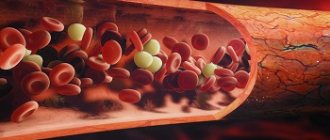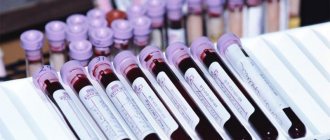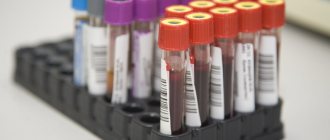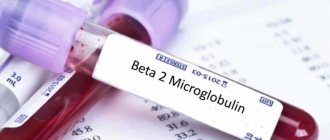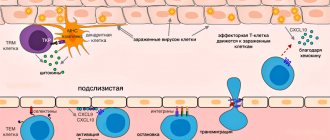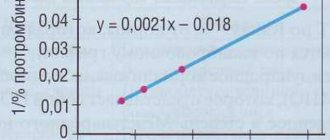Initial appointment with a THERAPIST with 25 years of experience
ONLY 1800 rubles!
(more about prices below)
To study the state of the blood coagulation system, a prothrombin test is used. In this article we will talk about what a blood test for prothrombin is and what the norm of this substance is. The study of prothrombin is one of the most important components of a coagulogram.
Get tested
If you are in doubt about the choice of laboratory testing, make an appointment with a therapist or consult by phone
+7
Price of a blood test for prothrombin
| Service | Price |
| Prothrombin (according to Quick) + INR | 250 rub. |
| APTT | 190 rub. |
| Thrombin time | 200 rub. |
| Fibrinogen | 190 rub. |
| Antithrombin III | 350 rub. |
| D-dimer | 1100 rub. |
| Protein S | 1700 rub. |
| Protein C Lupus anticoagulant | 1320 rub. |
Where to take a prothrombin test in St. Petersburg?
You can get tested for antibodies to prothrombin in St. Petersburg at our MRI center and RIORIT clinic. You can make an appointment and find out the cost of the examination by phone..
MRI and ultrasound center RIORIT
Area:
Kalininsky
Metro:
metro station Grazhdansky Prospekt, metro station Devyatkino, metro station Prospekt Prosveshcheniya
Address:
St. Petersburg, Kalininsky district, st. Rustaveli, 66 lit. G
Telephone:
Equipment:
Siemens, open type
Schedule:
Around the clock
What is important to know about registering for tests
Do I need to make an appointment: It is better to make an appointment for blood tests and smears to avoid waiting in the treatment room.
Opening hours of the treatment room: Mon - Fri from 8:00 to 12:00
Form of payment: cash, credit cards
Doctor's referral: not required
Minimum patient age: Urinalysis, stool test - any age, blood test - from 10 years
How quickly the results are ready: Average time 1-2 business days. Ready results can be received by email or during a second visit to the clinic
Blood clotting process
In order to understand what prothrombin time (PTT) is, it is necessary to consider the process of blood clotting.
Blood clotting is a complex process that starts when wounds appear. A blood clot forms on their surface, which prevents the infection from penetrating into the body and at the same time prevents large blood loss. Fibrinogen, a special blood protein, is responsible for this function. When injured, it is modified into dense fibrin threads, similar to a network. They prevent blood from leaving the wound. Thanks to fibrin, a blood clot is formed, which becomes denser over time, leading to wound healing.
The coagulation process consists of three stages and is a complex chain of molecular interactions:
Activation. At this stage, prothrombin, a complex protein, turns into thrombin.
Coagulation. At this stage, fibrin is formed from fibrinogen.
Retraction. At the final stage, a dense fibrin clot, a thrombus, is formed.
However, this scenario does not always work. If a person has serious illnesses, the clotting process is disrupted - this leads to an increase in the amount of time. As a result, the patient may experience severe bleeding.
There are other clotting disorders where a blood clot forms too quickly. This is possible because the blood becomes thicker and more viscous. This happens as a result of certain diseases. Early formation of blood clots is deadly for the body, because can lead to sudden death from heart attacks, strokes, gangrene of the limbs and other serious diseases.
To prevent such dangerous pathologies and for their early diagnosis, a blood test for prothrombin time is performed.
Prothrombin - what is it?
Prothrombin is a complex type of protein structure that is responsible for the state of the blood coagulation system and its ability to thicken. The human body needs blood in a liquid state: it transports useful substances to organs and tissues, protects against infections, and also maintains the desired body temperature. But, if some area of the external or internal tissues is injured, bleeding occurs. To stop it, a blood clot is created - a kind of plug that clogs the damaged area. The ability of blood to clot is used by the body precisely for the purpose of thrombus formation, and the most important participant in this process is prothrombin. A study of the prothrombin norm is performed in the following cases:
- Before surgery.
- During rehabilitation after injury or surgery.
- Before labor begins
- To diagnose the presence of diseases associated with blood clotting.
Prothrombin is formed in the liver; its synthesis is due to the presence of vitamin K in the body. By examining the prothrombin rate, the doctor can not only assess the functioning of the blood coagulation system, but also diagnose diseases of the digestive system and liver. It is possible to determine whether the level of prothrombin in the blood is normal by performing a test for the prothrombin index, also known as PTI. This parameter is calculated as a percentage of the normal time required for the blood clotting process to the actual plasma clotting time.
Methodology for studying prothrombin time
To determine the prothrombin time, fresh plasma from the patient being studied is used. The blood is collected in a tube containing sodium citrate to bind blood calcium. Next, the sample is mixed, centrifuged, and an excess amount of calcium is added at a temperature of 37C to restore the blood’s ability to clot. After this, tissue coagulation factor (better known as factor III) is added and the time of blood clot formation is noted.
It should be taken into account that in some pathologies the prothrombin time may be increased or decreased.
Prothrombin time is increased with:
1. Congenital deficiency of certain blood coagulation factors such as II (prothrombin), V (Proaccelerin), VII (Proconvertin), X (Stewart-Prower factor).
2. Acquired deficiency of blood coagulation factors resulting from diseases (chronic liver and kidney diseases, amyloidosis, autoimmune diseases).
3. Disseminated intravascular coagulation syndrome (DIC syndrome), which develops in blood diseases, including cancer.
4. The use of indirect anticoagulants (warfarin) in the main therapy.
5. Developmental hypovitaminosis K (for diseases of the pancreas and gall bladder, dysbacteriosis, malassorption syndrome).
6. An increase in the level of antithrombin in the blood.
The use of certain drugs also leads to an increase in prothrombin time (some antibiotics, steroid hormones, laxatives, acetylsalicylic acid in doses exceeding therapeutic ones).
Prothrombin time is reduced with:
1. Polycythemia.
2. Pregnancy in the last trimester.
3. Thrombosis of deep veins of the lower extremities.
4. Use of acetylsalicylic acid in small doses.
5. Taking oral contraceptives.
When is laboratory testing performed?
Prothrombin analysis is prescribed in the presence of the following conditions:
- Atherosclerotic changes.
- Varicose veins.
- Liver dysfunction.
- Changes in the coagulation system.
- With vitamin K deficiency.
- For antiphospholipid diseases.
- In case of autoimmune diseases.
- To monitor the process of treatment with anticoagulant drugs.
How to prepare for the analysis?
Prothrombin levels and its normal levels in the blood may vary depending on various factors. In order for the prothrombin test to give the most accurate results, it must be taken in compliance with certain rules, in particular:
- Come to the clinic on an empty stomach (at least four hours must pass after your last meal).
- Tell your doctor if you are taking any medications. If you are taking medications that affect blood clotting, notify your doctor about this before issuing a referral for testing.
When testing for prothrombin, the blood is placed in a special container filled with sodium citrate. After this, the substances are mixed and sent to a centrifuge, which allows the plasma to be separated from the blood cells. Then, when the process is completed, a tissue substance is placed in the container, on which the resulting solution is tested.
What to do with indicators that do not fit into the norm?
Prothrombin is increased or decreased, what to do?
First, you need to see a doctor. Many people think that the answers to all questions can now be found on the Internet. In fact, this is far from the case. This is especially true for the coagulation system. The information presented on the Internet about this matter is very confusing and 50% of it is completely wrong. This indicates the high complexity of this issue.
Which doctor should I contact?
To the one who ordered the analysis. If you took a coagulogram on your own, first we go to a therapist.
What should you definitely tell your doctor?
- You must list all medications that you are taking or have taken recently, including dietary supplements. Many medications tend to affect coagulogram parameters, and this applies not only to anticoagulants. Thus, Nevigramon, Streptomycin, Tetracycline, Levomycetin, L-thyroxine, vitamin A, and Aspirin in high doses can reduce prothrombin.
The following can increase PTI: contraceptive hormonal drugs, caffeine, antihistamines, high doses of vitamins C, K, corticosteroid hormones.
- Long-term alcohol abuse can also reduce PTI.
- An excess of foods rich in vitamin K in the diet can lead to an increase in prothrombin, and insufficient consumption of them can, on the contrary, lead to a decrease. These are foods such as greens, green vegetables and fruits, liver.
- Women must be informed about their pregnancy.
What additional examinations can be prescribed?
- Liver function test (advanced biochemical analysis with determination of bilirubin, liver transaminases, total protein, albumin).
- Ultrasound of the liver and biliary tract.
- Fibroelastography of the liver for suspected cirrhosis.
- Determination of antibodies to viral hepatitis.
- Extended examination of the coagulation system (APTT, fibrinogen, thrombin time, D-dimers, plasminogen, antithrombin III, plasma fibrinolytic activity, lupus anticoagulant, etc.)
- Intestinal examination (stool analysis for dysbacteriosis, colonoscopy).
How to lower or increase the prothrombin index?
If the readings are only slightly outside the normal range, there is no need to panic. It is possible that some time after stopping some medications, a repeat analysis will not reveal any abnormalities. Many women are concerned about the question - what to do with taking contraceptives? If cardiovascular diseases are diagnosed, definitely stop taking it, but if the woman is generally healthy, the pills can be taken, but the analysis should be periodically monitored.
You can also try to correct PTI with a diet if you are sure that your diet is clearly lacking foods such as greens (parsley, dill, spinach), vegetables (cabbage, broccoli), beef or pork liver. Green tea improves PTI quite well.
If prothrombin levels are elevated and there is a risk of thrombosis, doctors usually prescribe anticoagulants. At the same time, only warfarin will clearly reduce this indicator. New generation anticoagulants (Pradaxa, Xarelto, Eliquis and others) act on other coagulation factors, but the level of prothrombin may not change.
Aspirin also does not change this indicator, but taking it in small doses makes sense to reduce the risk of blood clots.
In what cases should you not waste time on a diet?
- If the coagulogram values are significantly higher or lower than normal.
- There are symptoms of impaired homeostasis: recurrent bleeding or thrombosis.
- Presence of pregnancy.
- Abnormal coagulogram in a child.
- There are other symptoms (yellow skin, dark urine, swelling, rash, itchy skin, etc.)
In these cases, you need to undergo a full examination and find out the cause of the pathology of the coagulation system.
Author:
Akimova Valentina Konstantinova general practitioner
Prothrombin according to Quick
The Quick prothrombin test is the most accurate way to analyze the activity of this protein, which leaves the prothrombin index test far behind. This is not the most common type of analysis. As a rule, it is performed during screening tests, in the presence of blood diseases, and also as a monitoring measure when the patient is using anticoagulant drugs. Normally, the Quick prothrombin percentage of 30-40% corresponds to 50-60% of the prothrombin index.
Prothrombin time indicators
Prothrombin time is a special laboratory indicator that reflects the external pathway of activation of the blood coagulation system.
Often, prothrombin time is determined with activated partial thromboplastin time (aPTT), which evaluates the intrinsic activation pathway. Taken together, these two indicators reflect the coagulation and anticoagulation systems as a whole and its changes in the pathology of internal organs.
The normal prothrombin time is 11-16 seconds.
Also, to determine the functions of the coagulation system, other indicators are determined - prothrombin index and international normalized ratio (INR).
Prothrombin index (PTI) is a percentage indicator determined by the ratio of the prothrombin time of control plasma to the PTI of the test human plasma. Normally it should be 95-105%.
International Normalized Ratio (INR) – This test compares blood taken from a patient to internationally normalized plasma.
The norm value can range from 0.85-1.25.
It should be borne in mind that during warfarin therapy, indicators may change, so it is necessary to take into account medical history.
Decoding and norm
The normal level of this substance in the blood can vary from 70 to 140%. Such a large difference between the upper and lower limits of the norm may be due to the influence of various factors - age and gender, pregnancy, taking certain medications. For example, the norm for prothrombin during pregnancy differs from the normal level for a woman who is not in an “interesting situation.” Also, for women, the prothrombin rate may vary depending on factors such as the day of the menstrual cycle. A general practitioner will help you make a competent interpretation of the prothrombin test in St. Petersburg
or a specialized specialist.
Prothrombin index during pregnancy
A hemostasiogram (coagulogram) during pregnancy is mandatory, since the prothrombin index of a pregnant woman is an important indicator that makes it possible to prevent severe bleeding during childbirth or prevent the formation of blood clots.
If a woman’s prothrombin index is reduced (less than 80%), then there is a risk of bleeding, and it makes sense to prescribe coagulants to the patient. If the prothrombin index is elevated, that is, it is about 100%, the pregnant woman is prescribed drugs that prevent increased blood clotting.
An important indicator for a pregnant woman is the prothrombin time. A doctor who knows the clotting time of a woman in labor can prevent bleeding or, if it does begin, the development of hemolytic shock, which in most cases is the cause of death of a woman during childbirth.
Pregnant women have different attitudes towards the need to register with an antenatal clinic. Some people follow all the doctor’s recommendations, while others believe that a large number of tests only harms their health and family budget.
The main thing that a pregnant woman should remember is that if the doctor does not know that her prothrombin index is low, he will not be able to prevent placental abruption or bleeding after childbirth, and vice versa, a high prothrombin index will be able to promptly indicate to the doctor the danger of developing placental vascular thrombosis.
Prothrombin according to Quick is reduced
Prothrombin will show a value below normal if the patient has the following diseases or conditions:
- lack of fibrinogen in the blood;
- liver diseases characterized by changes in the process of synthesis of blood clotting factors;
- congenital deficiency of certain blood clotting factors;
- hypoprothrombinemia;
- lack of vitamin K;
- taking anticoagulant drugs, coumarins, steroids, thyroxine and other substances that weaken the effect of vitamin K.
Quick prothrombin below normal is also one of the signs of leukemia. Low prothrombin may indirectly indicate the presence of hepatitis and a disease such as cirrhosis.
If the test results show a prothrombin level below normal, do not rush to get upset. Low prothrombin is not the only indicator by which the state of the blood coagulation system is determined. Contact a competent and experienced specialist who, after reading the transcript, will give comprehensive advice on your health.
Reasons for increased prothrombin and PTI
An increase in PTI indicates hypercoagulation and is dangerous for the development of thrombosis (heart attacks, strokes, thrombosis of the veins in the legs, pulmonary embolism). This condition is especially unfavorable after operations and after childbirth.
- Last weeks of pregnancy.
- DIC – syndrome (1st stage).
- The use of estrogen-containing hormones by women (and sometimes men).
- Congenital thrombophilia.
- Excess vitamin K.
- Mutation of the prothrombin gene G20210A (carriers of the defective gene are 2-3% of the population).
- The period after severe operations, burn disease.
- Postpartum stage.
- Malignant tumors.
- Antithrombin III deficiency.
- Antiphospholipid syndrome.
